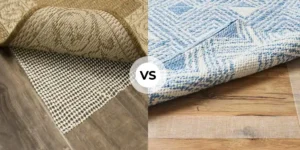Are you tired of finding that your bed is sliding across your laminate floor like it’s attached to an ice skate? Don’t be worried. It is not just you who suffers from this challenge, millions of people do as well.
As we all know, laminate floors have a slippery surface. So, when people place lightweight bed frames they tend to experience this problem.
A bed that slides on laminate flooring is not a problem until it starts to damage the laminate floor. Plus, a sliding bed poses another major disadvantage. Especially if you have children who like to jump on the bed.
The force of the jumping can cause the bed to move, damaging the laminate flooring. In addition, if the bed is not secured properly, it can easily tip over and cause serious injury.
So, now here a question comes up: How to stop the bed moving on the laminate floor?
In this article, we’ve outlined a few steps you can take to stop beds from moving on laminate floors.
Why Do We Need To Stop Bed Moving?
Stopping your bed from moving is all about making your sleep space safer, and comfortable. Plus, protecting both your bed and your floor.
Stopping your bed from moving is important for a few reasons:
- Sleep Comfort: When the bed slides around, it can mess up your sleep setup. Nobody likes waking up to find their bed out of place or at a weird angle.
- Safety: A moving bed can be a safety hazard, especially if it has sharp corners. Keeping it steady helps avoid accidents, especially if you have kids or pets around.
- Floor Protection: If your bed is sliding, it can scratch or damage the laminate floor over time. Stopping the movement helps keep your floor in good shape.
- Noise Reduction: A moving bed can create annoying squeaks or creaks, disrupting a peaceful night’s sleep. Keeping it still reduces unnecessary noise.
How to Stop Bed Moving on Laminate Floor?
Move your Bed To the Corners
People have been using the old trick of moving their bed to the corner of the room for centuries. This method keeps your bed from sliding out of position when it shifts due to sleep patterns.
Plus, it eliminates the need to adjust the bedding every morning.
However, moving your bed to the corners won’t directly stop it from sliding on a laminate floor.
The key is what’s under the bed, not just where it’s located in the room. So, consider using rugs and non-slip pads under the bed legs to keep it steady, no matter where it is in the room.
Place a Rug Beneath your Bed Frame
There’s a good chance that your bed frame is slipping around because it cannot get a good grip. Especially if you have laminate flooring.
Place a rug or carpet under the legs of your bed. This adds traction and helps prevent it from slipping.
You can use some cool rugs to give your bedroom a good style, and no one will even know it’s there to keep the bed from moving.
This hack is often preferred over furniture cups. As it is more aesthetically pleasing.
See Also: How to Choose the Right Area Rug for Under Your Bed?
Put Non-Slip Furniture Pads on Bed Feet
Stick rubber grippers or non-slip pads under each bed leg. These can be found at most home improvement stores and are easy to attach. And are designed to be placed under furniture legs. So, they don’t slide around on the floor.
Plus, it prevents them from coming off even with the slightest movement. They’ll stay in place for a very long time.
Also, these grippers protect your laminate floor from scratches and dents.
Must See: 7 Best Furniture Pads for Laminate Floors (Buying Guide Included)
Use Velcro Pads
Well, the Velcro pads should be your best option for this problem.
Attach Velcro strips between the bed legs and the floor. This can create a strong grip to keep the bed stationary.
Apart from being thin, these pads come in different sizes to meet your specific needs.
Not only are the velcro pads effective, but they are also budget-friendly. After slotted under your bed, it effortlessly sticks there and does what it has been designated to do.
But remember that you should stick your velcro pad to your laminate floor with glue.
The velcro pads might not be the perfect choice if you plan to change your bed position in the future. With this option, you should use removable velcro pads, so you can rearrange your bed at any time.
Try Furniture Cups on the Bed Legs
A furniture cup is a thick rubber stopper that attaches to the bottom of the legs of your bed frame. They are available in various shapes, sizes, and colors so that they won’t ruin the look of your room.
Also, they are less expensive and can be bought at most hardware stores. They are also known as bumper feet.
Invest in a set of Bed Risers
A set of bed risers provides extra grip on your floor. But they also lift your bed frame off of the ground.
So that you can store extra clothes or other items underneath the bed.
Bed risers typically lift your bed frame anywhere between 6 inches and 2 feet. Aside from choosing height, bed risers have several different shapes and sizes. Pick the one that you think looks best under your frame.
Mount the Headboard to the Wall
To stop your bed from moving on a laminate floor by mounting the headboard to the wall.
Follow these simple steps:
- Get Wall Mounts: Buy wall mounts or brackets suitable for your headboard. You can find these at most hardware stores.
- Measure and Mark: Measure the height you want for your headboard and mark the wall accordingly. Use a level to make sure it’s straight.
- Attach Wall Mounts: Securely attach the wall mounts to the wall at the marked spots. Make sure they are level and firmly screwed into the wall.
- Align Headboard: Align the headboard with the wall mounts and attach it securely. Follow the manufacturer’s instructions for the specific wall mounts you have.
- Check Stability: Give the headboard a gentle shake to ensure it’s securely attached. It should be stable and not wobble.
- Secure Additional Support (Optional): If your headboard is large or heavy. Consider adding more support by attaching a piece of wood horizontally between the wall mounts.
Read More on Laminate Floors
- 7 Best Furniture Pads for Laminate Floors (Buying Guide Included)
- How to Remove Scuff Marks from Laminate Flooring? (4 Helpful Solutions)
- Does Laminate Flooring Make Your House Colder? (Explained)
- 9 Best Ways to Keep Rugs From Slipping on Laminate Floors (Must-Try!)
- 7 Best Ways to Fix Peeling Laminate Floor (Must-Try!)





